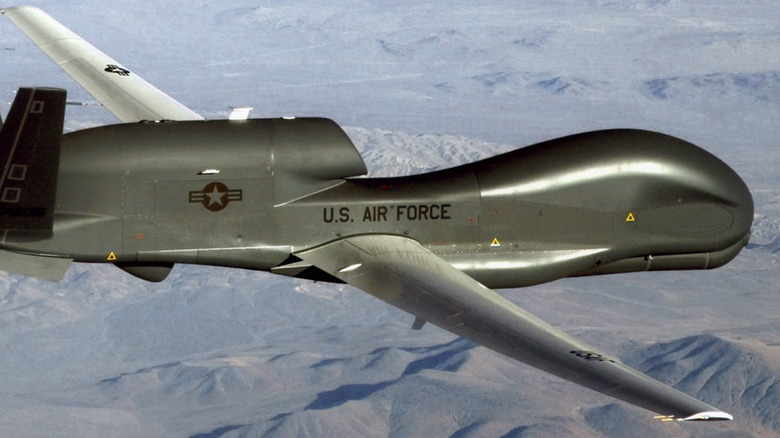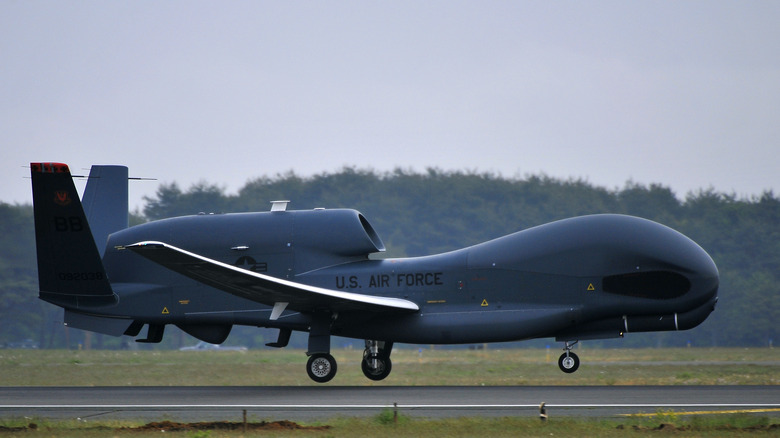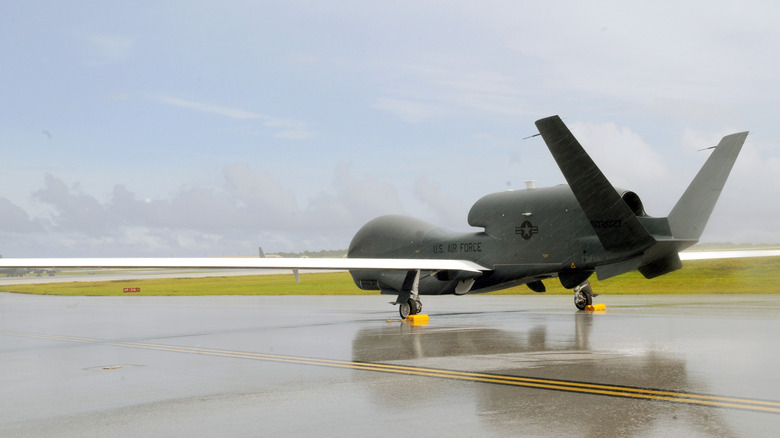This Massive Military Drone Is Designed To Provide Surveillance In Any Weather
Aerial drones have been part of the battlefield for the past couple of decades and come in all different shapes and sizes. Some are as small as toy helicopters and can easily slip in and out of dangerous areas to provide surveillance without being seen. Others, like the MQ-9 Reaper drone, are much larger and can attack enemy targets and give a bird's eye view to troops on the ground without putting other forces in danger. Larger still is the Northrop Grumman RQ-4 "Global Hawk" drone.
With a wingspan of over 130 feet, the RQ-4 is wider than a Boeing 737-800 passenger plane, but with a length of over 47 feet, it's much shorter, compared to the 737's 129 and a half feet. The massive wingspan combined with the stubby fuselage lends a bizarre, somewhat aquatic creature look to the Global Hawk. The huge hump on the front of the drone doesn't help matters much.
Despite its size and the fact it doesn't carry any weapons, the Global Hawk is still an incredibly formidable piece of machinery in any fight. The airframe is packed to the brim with surveillance equipment to give teams on the ground anywhere on Earth a real-time view of what's happening in the sky, sea, or on the ground, regardless of the weather.
An unblinking eye in the sky
Officially, the Global Hawk has been in service since 2001, according to the United States Air Force, but it was first developed as far back as 1995. As with most surveillance apparatuses, specifics are classified. But it's safe to say the RQ-4 has been in the skies for a while. In addition to looking flat-out goofy, the Global Hawk also isn't very fast, topping out at 357 miles per hour. The drone is huge, slow, and doesn't carry any weapons. So what is it good for?
The RQ-4 excels in staying out of harm's way and endurance. It has a ceiling of around 60,000 feet, allowing it to stay safely out of the way of any unfriendly air traffic that might be trying to interfere. It's also capable of staying in the air for absurd amounts of time. Without refueling, a Global Hawk drone can stay on mission for more than 34 hours. There's no onboard crew that gets tired, hungry, or bored, so it can stay aloft as long as its engines are still running. It takes three operators on the ground to keep an RQ-4 on the prowl.
RQ-4s have been used on humanitarian missions to relay information to rescue workers on the ground during the cleanup after Japan's earthquake and tsunami in 2011. On the battlefields of today, the United States Air Force is using multiple Global Hawks to monitor the conflict in Ukraine, keeping at least one RQ-4 in the air ever since Russian forces invaded in 2022.
Always in the air
The RQ-4 may not be as sleek and stylish as an F-22 Raptor, or as outright deadly as the MQ-9 Reaper, but it's no less important. With the Global Hawk providing an unblinking eye over the battlefield, troops can always stay up to date on enemy movement. It's a little hard to stay out of the watchful gaze of a plane as wide as a passenger jet that can stay in the sky for nearly two days without skipping a beat.
The Global Hawk is powered by a Rolls-Royce North American turbofan engine that generates 7,600 pounds of thrust and weighs 14,950 pounds unloaded. To the public's knowledge, there are currently 33 Global Hawk drones in the Air Force's repertoire. According to the U.S.A.F., Global Hawks are operated by both the 12th Reconnaissance Squadron out of California, and the 348th Reconnaissance Squadron in North Dakota, but it's launched from airfields all over the world.


